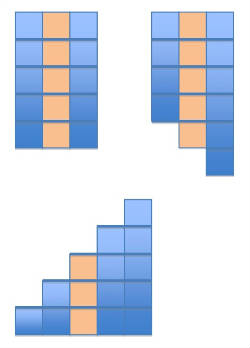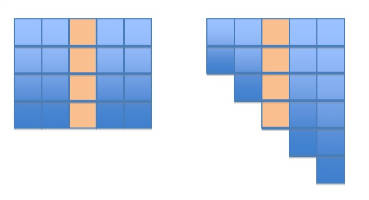Which Whole Numbers Can
Be Written as the Sum of Consecutive Whole Numbers?
Consider, for example, that 6 = 1 + 2 + 3 and 15 = 4 + 5 + 6. Thus, 6 and 15 are whole numbers that can be written as consecutive sums. It is also the case that 15 = 7 + 8.
A natural extension of this problem might be the following question: How many different ways can a given whole number be written as a consecutive sum?
Solution:
The August Problem to Ponder was this: Which whole numbers can be written as the sum of consecutive whole numbers? An extension also asked, How many different ways can a given whole number be written as the sum of consecutive whole numbers?
One of the first observations that many people make on this problem is that every odd number can be written as the sum of twoconsecutive whole numbers, for example,
5 = 2 + 3, 15 = 7 + 8, and 87 = 43 + 44. In general, since every odd whole number can be written in the form 2n + 1 where n is some other whole number, and since (2n + 1) = n + (n + 1), then every odd whole number can be expressed as the sum of two consecutive whole
numbers.
You may also have discovered that some whole numbers cannot be written as any consecutive sum. For example, 2 cannot be written as the consecutive sum of whole numbers, because the only possible choices for addends are 0 and 1. Another number that cannot be written as a consecutive sum is 8, because 2 + 3
+ 4 = 9 (already too big) and 1 + 2 + 3 = 6 (too small). Because all other possibilities are much bigger or much smaller, we can prove that 8 cannot be written as a consecutive sum of whole numbers.
So far, we now know that all odd numbers canbe written as a consecutive sum, that some even numbers can be, but that other even numbers cannot. We also know that many numbers can be written as a consecutive sum in more than one way.
Which even numbers cannot be written as a consecutive sum? Why? And, for those numbers that can be written as a consecutive sum, how can we predict the number of different ways that they can be written as a consecutive sum?
More Reasoning:
15 = 3 x 5 can be represented by a rectangular grid (see left figure below). The area of this figure can then be rearranged into columns that represent the consecutive sum 4 + 5 + 6, as seen in the figure on the right below. Similarly, 15 = 5 x 3 can be rearranged into another consecutive
sum, 1 + 2 + 3 + 4 + 5 as shown in the third figure below. In each case, we can make “trades” of the squares in the grid across the middle column (shown in a different color). The height of the middle column is one of the factors of 15 (5 in the first case, and 3 in the second). As long as we have an odd factor in our number, we can make
these trades, and write our number as a consecutive sum.

Similarly, we can represent 20 = 5 x 4 in a rectangular grid if we create 5 copies of 4, and we can trade cubes across the middle column to write the consecutive sum 20 = 2 + 3 + 4 + 5 + 6.
In this way, we can create a consecutive sum determined by each odd factor of a number. Any number with an odd factor can be written as a consecutive sum. So, what numbers cannot be written as consecutive sums? You should have the answer by now!
